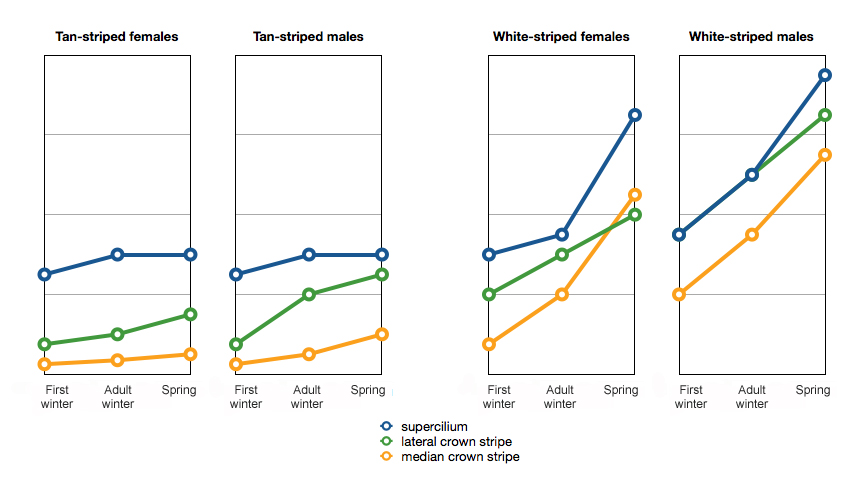White-throated Sparrow Zonotrichia albicollis
Geographic Variation
None
Color Morphs
White-throated Sparrow occurs in two distinct morphs commonly known as White-striped and Tan-striped (first described by Lowther, 1961) ((I find it easier and more intuitive to call the morphs black-striped and brown-striped, since the color of the dark lateral crown stripes is easier to judge, and a little less overlapping, than the color of the pale head stripes)). These two morphs occur in almost exactly equal proportions throughout the range of the species. Several studies have found a slightly higher proportion of White-striped birds among males than among females (e.g. Piper and Wiley, 1989), but others have found equal numbers of males and females of each morph (Falls and Kopachena, 2010). The morphs differ primarily in plumage color but also differ slightly in size and behavior.
Differences in plumage: White-striped birds (vs. Tan-striped)
- clean black-and-white head stripes (vs. dark brown/black and pale tan)
- unstreaked gray breast (vs. drab gray-brown, streaked and mottled darker)
- clean gray cheeks (vs. mottled and washed with brown)
- sharply-contrasting clean white throat with clean border (vs. drab white with mottled border and divided by dark lateral throat stripe)
- brighter and cleaner yellow loral spot (vs drabber)
I think this is mainly an artifact of the brighter head stripes, with less tan color to “muddy” the yellow, but there may actually be a difference in the extent of yellow.
- upperparts and wing coverts average “cleaner-looking” and richer rufous (vs. drabber brown)

The charts above show the average plumage score of females and males of the two morphs for each of three plumage features (from Piper and Wiley, 1989). Note that these are average values and there is considerable variation around the average values shown in the chart above. Also note that the color and pattern of breast, throat, and cheeks – which all differ at least as much as head stripes between the two morphs – were not measured by Piper and Wiley and are not include in the charts above.
Females are very similar to males but generally slightly drabber. Immatures are drabber than adults, especially in the White-striped morph. Tan-striped birds change little with age or season, while White-striped birds vary significantly with age and season. They are similar to Tan-striped in fall and winter but become much brighter in spring and summer. This spring molt occurs between late March and early May.
Differences in behavior
Comparing like sexes, White-striped birds are more aggressive, sing more, and spend less time in parental care than Tan-striped. Regardless of sex, White-striped tend to dominate Tan-striped birds in the breeding season. Mated pairs almost always include one of each morph, and because of the chromosome arrangement this pairing always produces equal numbers of Tan-striped and White-striped offspring (Falls and Kopachena, 2010).
Differences in size
White-striped birds average about 2-3% larger than Tan-striped in all measurements.
References
Atkinson, C. T. and C. J. Ralph. 1980. Acquisition of plumage polymorphism in White-throated Sparrows. Auk 97:245-252. http://elibrary.unm.edu/sora/Auk/v097n02/p0245-p0252.pdf
Falls, J. B. and J. G. Kopachena. 2010. White-throated Sparrow (Zonotrichia albicollis), The Birds of North America Online (A. Poole, Ed.). Ithaca: Cornell Lab of Ornithology; Retrieved from the Birds of North America Online: http://bna.birds.cornell.edu/bna/species/128
Lowther, J. K. 1961. Polymorphism in the White-throated Sparrow, Zonotrichia albicollis (Gmelin). Can. J. Zool. 39:281-292.
Piper, W. H. and R. H. Wiley. 1989. Distinguishing morphs of the White-throated Sparrow in basic plumage. J. Field Ornithol. 60:73-83. http://elibrary.unm.edu/sora/JFO/v060n01/p0073-p0083.pdf
Vardy, L. E. D. Color Variation in the Crown of the White-throated Sparrow, Zonotrichia albicollis. http://elibrary.unm.edu/sora/Condor/files/issues/v073n04/p0401-p0414.pdf


Do the different color morphs migrate at different times? I saw my first batch of Dark-eyed Juncos and WTS (2 individuals) yesterday, and both the White-Throats were tan morphs.
one of each (tan and white) here today first of season (April 23, 2016). Is it true that each breeding pair usually consists of one of each? I have to admit I have never been particularly aware of the tan-coloured although apparently it is as common as the white variety.
K. Popma
Sackville, NB
Canada
BTW, I live in Baltimore, MD.
Woods today were full of white-throateds esp their songs. Is all their breeding and hatching of youngsters done in northern territory? Wondering if one i saw today was a young one. Here in northern Virginia – when do they arrive? Leave? Does weather have anything to do with dates?
Just moved to the country here in southern Illinois, amazed at how many different kinds of birds are coming to feeder. Most easily identified, including Eurasian Tree sparrows! But one bird I’m not sure. Seems to be a white throated sparrow, but colors are not as sharp as the images I see on line. Since our viewing window is above the feeder, looking down there are all these ‘brownish sparrow’ types with stripes on head – and white color under beak (throat area) their head stripes remind me of the University of Michigan football helmets . . . what are these birds? White Throated Sparrows?